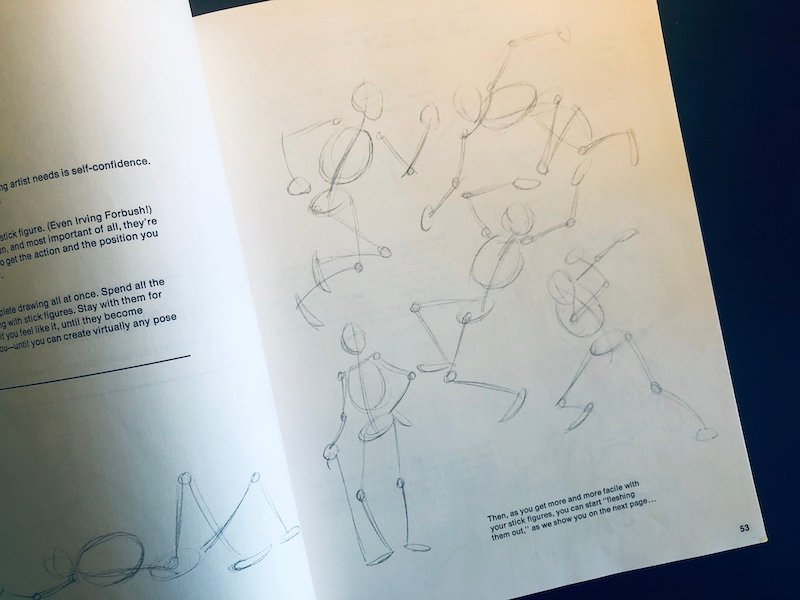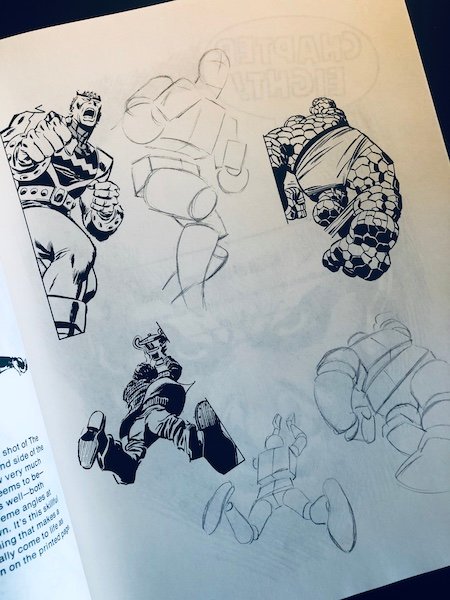"How to Draw Comics the Marvel Way", a Classic and Timeless Resource for Creating Comics
13 comments
Originally published in 1978, How to Draw Comics the Marvel Way was one of the first instructional volumes dedicated specifically to the art of creating comic books. Its enduring popularity has allowed it to remain perpetually in print to the present day. Written by industry legends Stan Lee and John Buscema, How to Draw Comics the Marvel Way was based off of art classes Buscema was teaching in the mid 1970’s and features his excellent draftsmanship in the instructional examples, accompanied by Stan Lee’s inimitable prose passages of explanation and encouragement. Along the way the book also features example artwork by other titans of the early comic book industry such as Neal Adams, Ross Andru, Gene Colan, Jack Kirby, and John Romita.

As one of the only books at the time tackling the subject of creating comics, How to Draw Comics the Marvel Way held a special place in shaping a generation of new creators. In a way, it existed in a time of transition as a midway step between the earlier studio “sweatshops” & bullpens with their accompanying systems of trade apprenticeship; and the age of the internet to follow that would open up the sharing and study of this kind of instructional information on a vast scale. Nowadays an unlimited number of tutorials and educational videos can be found with a few keystrokes, and there has been a great proliferation of academic study and published books specifically on the medium of comics. But it wasn’t that long ago that How to Draw Comics the Marvel Way was about all there was!
I’m not sure the exact year, but I acquired my copy of How to Draw Comics the Marvel Way in 1988 or 1989 as an 8 or 9 year old kid. I have it to this day. A few pages are falling out as the binding loosens and it shows the wear of frequent reading in my youth. It remains a treasured artifact for me, and surprisingly still a resource that I can turn to.
My shopworn copy bears the marks of my young determination and planning. I made myself little checklists and assignments to complete, wanting to seriously study as much of this amazing knowledge as I could! (I’m not sure how many of those assignments I ever completed… as ever, planning can be easier than execution!)

Before discovering How to Draw Comics the Marvel Way at a local mall bookstore; (quite possibly the same one where I’d first discovered comics in general a year before), the only drawing instruction books I’d “read” had been the Lee J. Ames “Draw 50” series which always showed the steps of drawing 50 different objects of a certain theme; dogs, boats, monsters, airplanes, etc. Anyone who recalls these books may remember they were entirely pictorial. Aspiring artists read them like a set of modern Ikea instructions… piecing together how to draw a parrot or battleship by building it up with center lines, circles and squares. The fundamental approach was there, but it didn’t explain the whys, or motivate the artist to invent on their own and apply these steps to everything they see. How to Draw Comics the Marvel Way did, and in doing so helped open up whole new ways of thinking about drawing. Being such a broad overview, the book couldn’t hope to educate fully, so it did the next best thing by teaching the aspiring artist how to think critically. To this day the book remains one of the best primers and broad course overviews into the infinite world of creating comics.
How to Draw Comics the Marvel Way touches on almost every major facet of creating comics. It features chapters on basic terminology, art tools, form, perspective, figure drawing, foreshortening, composition, inking, and some of the concerns unique to designing comic book pages and covers. After reading and studying Buscema’s art and Lee’s words, serious artists will move on to “fill in the gaps” and seek out more education. Dedicated books and courses on anatomy, perspective and composition and a lifetime of study and practice are to follow. How to Draw Comics the Marvel Way sets you on the path to knowing what you don’t know… and just what questions to ask.

All that being said, the lessons contained within the book are still remarkable in their own right, and something even a veteran artist can revisit every few years to gain new ideas and inspiration! Stan’s prose is unmistakably his voice and John’s clear and elegant pencil work is a beauty to behold.

Many of these lessons promote rules and techniques that the vast majority of working artists don’t strictly adhere to. Very few comic artists in their preliminary work go so far into constructing their figures out of spheres, cylinders, and cubes as Buscema demonstrates in these pages. However these visuals deftly demonstrate the principles of composition and foreshortening and are perhaps the best way of teaching. All those torso and pelvis cubes are quite literally the building blocks of figure drawing. As the saying goes, “You have to know the rules before you can break them.” With practice and experience most artists will create a figure drawing “mannequin” in their own style, which is less engineered and more intuitive. However those blocks and cylinders are always faithfully waiting in the wings to dust off and help the artist think through and solve a tricky problem. Just like in giving birthday gifts… when it comes to art it’s the thought that counts.

Being mainly the vision of one artist… Buscema; How to Draw Comics the Marvel Way does teach to a specific style of illustration, what is often referred to as a “house” style. It does nothing to hide this fact, after all… it’s not just called “How to Draw Comics!” That Marvel Way counts for something! Nowadays, even within the halls of major publishers like Marvel and DC, there is a much broader proliferation of styles and techniques on display. The concept of a “house style” has diminished in the past decades as the art form of comics has evolved and become more diverse. However the foundational material presented within still underpins almost any style or genre. Again, this book is a start, an introduction… there is no endgame to art, no finish… only a lifetime of pursuit!

In 1988 a How to Draw Comics the Marvel Way video was produced as well. I assume it’s out of print/distribution and as such has remained freely available after being uploaded to YouTube and other sites.
The video is a pretty direct walkthrough of the book, showing many of its graphics with Stan reciting quite a bit of the prose components nearly word for word. It’s a fun gateway to the past, especially to see Stan and John in the flesh as both these comic legends are no longer with us. It also might be the first time I learned how to correctly pronounce “Buscema!”
There is certainly a bit more in the book than the video, but not by much! The main difference though is that if you really want to pore over the illustrations and examples and study this topic, the book is much more needed. The video doesn’t have much in the way of drawing demonstration. Sadly Buscema is relegated mainly to pointing at things with his pencil tip, or tracing over the book diagrams as if he’s drawing them fresh. If you want to see actual drawing process videos, YouTube is filled to the brim with talented artists sharing. The video version is best for folks who are curious, or comics fans with an appreciation of the art form and want to see that broad overview and a look at a couple of the men who shaped the industry. It’s just a fun time capsule… that music though… whew!
-Bryan "the Imp" Imhoff
all photos featured are my own, taken of my own beloved childhood copy of How to Draw Comics the Marvel Way, and are used here under fair use for purposes of review. If you'd like to add a copy to your own collection, consider ordering through bookshop.org, a site with a mission to support local brick & mortar bookstores, authors, and fans like me!

Disclosure: I am an affiliate of Bookshop.org and I will earn a commission if you click through and make a purchase.
Comments